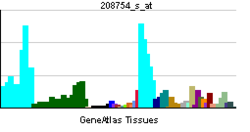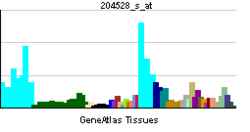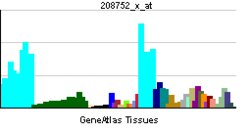- NAP1L1
-
Nucleosome assembly protein 1-like 1 Identifiers Symbols NAP1L1; FLJ16112; MGC23410; MGC8688; NAP1; NAP1L; NRP External IDs OMIM: 164060 MGI: 1855693 HomoloGene: 4355 GeneCards: NAP1L1 Gene Gene Ontology Molecular function • protein binding Cellular component • nucleus
• chromatin assembly complex
• melanosomeBiological process • DNA replication
• nucleosome assembly
• positive regulation of cell proliferationSources: Amigo / QuickGO RNA expression pattern 


More reference expression data Orthologs Species Human Mouse Entrez 4673 53605 Ensembl ENSG00000187109 ENSMUSG00000058799 UniProt P55209 Q3TF41 RefSeq (mRNA) NM_004537.4 NM_015781 RefSeq (protein) NP_004528.1 NP_056596 Location (UCSC) Chr 12:
76.44 – 76.48 MbChr 10:
110.91 – 110.94 MbPubMed search [1] [2] Nucleosome assembly protein 1-like 1 is a protein that in humans is encoded by the NAP1L1 gene.[1][2]
This gene encodes a member of the nucleosome assembly protein (NAP) family. This protein participates in DNA replication and may play a role in modulating chromatin formation and contribute to the regulation of cell proliferation. Alternative splicing of this gene results in several transcript variants; however, not all have been fully described.[2]
References
- ^ Simon HU, Mills GB, Kozlowski M, Hogg D, Branch D, Ishimi Y, Siminovitch KA (Mar 1994). "Molecular characterization of hNRP, a cDNA encoding a human nucleosome-assembly-protein-I-related gene product involved in the induction of cell proliferation". Biochem J 297 ( Pt 2): 389–97. PMC 1137842. PMID 8297347. http://www.pubmedcentral.nih.gov/articlerender.fcgi?tool=pmcentrez&artid=1137842.
- ^ a b "Entrez Gene: NAP1L1 nucleosome assembly protein 1-like 1". http://www.ncbi.nlm.nih.gov/sites/entrez?Db=gene&Cmd=ShowDetailView&TermToSearch=4673.
Further reading
- Kato S, Sekine S, Oh SW, et al. (1995). "Construction of a human full-length cDNA bank.". Gene 150 (2): 243–50. doi:10.1016/0378-1119(94)90433-2. PMID 7821789.
- Asahara H, Tartare-Deckert S, Nakagawa T, et al. (2002). "Dual roles of p300 in chromatin assembly and transcriptional activation in cooperation with nucleosome assembly protein 1 in vitro.". Mol. Cell. Biol. 22 (9): 2974–83. doi:10.1128/MCB.22.9.2974-2983.2002. PMC 133748. PMID 11940655. http://www.pubmedcentral.nih.gov/articlerender.fcgi?tool=pmcentrez&artid=133748.
- Strausberg RL, Feingold EA, Grouse LH, et al. (2003). "Generation and initial analysis of more than 15,000 full-length human and mouse cDNA sequences.". Proc. Natl. Acad. Sci. U.S.A. 99 (26): 16899–903. doi:10.1073/pnas.242603899. PMC 139241. PMID 12477932. http://www.pubmedcentral.nih.gov/articlerender.fcgi?tool=pmcentrez&artid=139241.
- Ota T, Suzuki Y, Nishikawa T, et al. (2004). "Complete sequencing and characterization of 21,243 full-length human cDNAs.". Nat. Genet. 36 (1): 40–5. doi:10.1038/ng1285. PMID 14702039.
- Bouwmeester T, Bauch A, Ruffner H, et al. (2004). "A physical and functional map of the human TNF-alpha/NF-kappa B signal transduction pathway.". Nat. Cell Biol. 6 (2): 97–105. doi:10.1038/ncb1086. PMID 14743216.
- Rehtanz M, Schmidt HM, Warthorst U, Steger G (2004). "Direct interaction between nucleosome assembly protein 1 and the papillomavirus E2 proteins involved in activation of transcription.". Mol. Cell. Biol. 24 (5): 2153–68. doi:10.1128/MCB.24.5.2153-2168.2004. PMC 350572. PMID 14966293. http://www.pubmedcentral.nih.gov/articlerender.fcgi?tool=pmcentrez&artid=350572.
- Kho Y, Kim SC, Jiang C, et al. (2004). "A tagging-via-substrate technology for detection and proteomics of farnesylated proteins.". Proc. Natl. Acad. Sci. U.S.A. 101 (34): 12479–84. doi:10.1073/pnas.0403413101. PMC 515085. PMID 15308774. http://www.pubmedcentral.nih.gov/articlerender.fcgi?tool=pmcentrez&artid=515085.
- Ballif BA, Villén J, Beausoleil SA, et al. (2005). "Phosphoproteomic analysis of the developing mouse brain.". Mol. Cell Proteomics 3 (11): 1093–101. doi:10.1074/mcp.M400085-MCP200. PMID 15345747.
- Gerhard DS, Wagner L, Feingold EA, et al. (2004). "The status, quality, and expansion of the NIH full-length cDNA project: the Mammalian Gene Collection (MGC).". Genome Res. 14 (10B): 2121–7. doi:10.1101/gr.2596504. PMC 528928. PMID 15489334. http://www.pubmedcentral.nih.gov/articlerender.fcgi?tool=pmcentrez&artid=528928.
- Okuwaki M, Kato K, Shimahara H, et al. (2005). "Assembly and disassembly of nucleosome core particles containing histone variants by human nucleosome assembly protein I.". Mol. Cell. Biol. 25 (23): 10639–51. doi:10.1128/MCB.25.23.10639-10651.2005. PMC 1291234. PMID 16287874. http://www.pubmedcentral.nih.gov/articlerender.fcgi?tool=pmcentrez&artid=1291234.
- Nousiainen M, Silljé HH, Sauer G, et al. (2006). "Phosphoproteome analysis of the human mitotic spindle.". Proc. Natl. Acad. Sci. U.S.A. 103 (14): 5391–6. doi:10.1073/pnas.0507066103. PMC 1459365. PMID 16565220. http://www.pubmedcentral.nih.gov/articlerender.fcgi?tool=pmcentrez&artid=1459365.
- Beausoleil SA, Villén J, Gerber SA, et al. (2006). "A probability-based approach for high-throughput protein phosphorylation analysis and site localization.". Nat. Biotechnol. 24 (10): 1285–92. doi:10.1038/nbt1240. PMID 16964243.
- Chi A, Valencia JC, Hu ZZ, et al. (2007). "Proteomic and bioinformatic characterization of the biogenesis and function of melanosomes.". J. Proteome Res. 5 (11): 3135–44. doi:10.1021/pr060363j. PMID 17081065.
- Olsen JV, Blagoev B, Gnad F, et al. (2006). "Global, in vivo, and site-specific phosphorylation dynamics in signaling networks.". Cell 127 (3): 635–48. doi:10.1016/j.cell.2006.09.026. PMID 17081983.
- Eckey M, Hong W, Papaioannou M, Baniahmad A (2007). "The nucleosome assembly activity of NAP1 is enhanced by Alien.". Mol. Cell. Biol. 27 (10): 3557–68. doi:10.1128/MCB.01106-06. PMC 1899999. PMID 17339334. http://www.pubmedcentral.nih.gov/articlerender.fcgi?tool=pmcentrez&artid=1899999.
Categories:- Human proteins
- Chromosome 12 gene stubs
Wikimedia Foundation. 2010.
